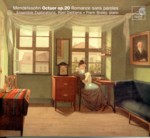First a little bit of housekeeping: what is billed as the Albumblatt Op. 117 for solo piano, the last track on the disc, is in fact the Assai tranquillo for cello and piano, a fragment composed on June 25, 1835 during a trip from Düsseldorf to Leipzig, not published until the 1960s and first recorded by Hyperion on its album of Mendelssohn’s complete chamber music for cello and piano. This sort of lapse is highly atypical of Harmonia Mundi, but as the piece is not listed in the old New Grove, it did provide a few minutes of fun dusting off some long-unplayed Mendelssohn CDs and trying to figure out exactly what had happened. In case you’re curious (about a piece lasting less than four minutes), this performance sounds a touch lugubrious when compared to the gentler, more flowing Hyperion rendition (and it’s been recorded elsewhere as well, notably by Analekta on another disc of Mendelssohn’s works for cello and piano that our own Jed Distler rated very highly). So if you are an avid Assai tranquillo collector and are still vacillating even after the shameful slap in the face inflicted on it here, you may want to pass on this disc.
Otherwise, I have nothing but praise for a lovely, well chosen program that perfectly captures the spirit of domestic music-making chez Mendelssohn. Pianist Frank Braley plays a delightful-sounding 1874 Steinway in the Romance sans paroles Op. 109 and in the Variations concertantes Op. 17, and he’s ably partnered in both works by Ensemble Explorations cellist Roel Dieltens. Of course, the main event is the Octet, which receives a richly textured performance that very much heeds Mendelssohn’s direction to “play it like a symphony”.
The first movement surges youthfully forward, with bold contrasts between the first and second subjects, and both the lyrical andante and gossamer scherzo have plenty of poise and polish, two qualities that the music cannot live without. In the latter, there is perhaps a slight tendency to lose rhythmic focus at the softest dynamic levels, but the vigorous and very powerful account of the finale more than compensates, bringing the performance to a memorable conclusion. Unlike some other recent Harmonia Mundi recordings of chamber music, the sonics are also excellent, giving the players enough room so that their tone acquires impressive body and depth, and their breathing doesn’t become irritating. In short, this is a very pretty (in the best sense) recording of very pretty music, whatever it’s called.
































